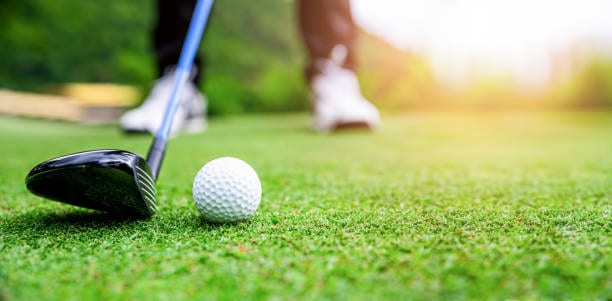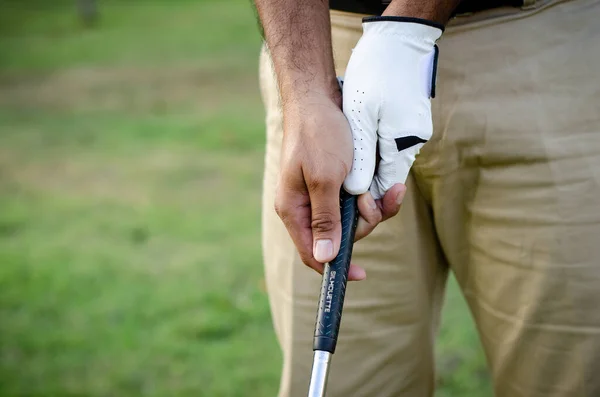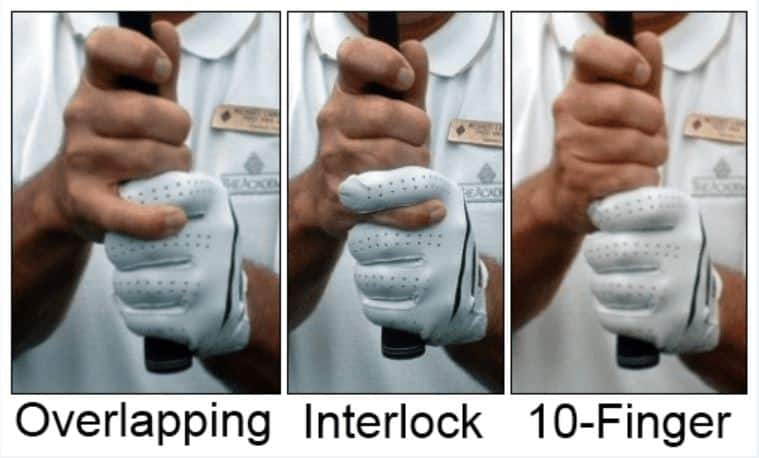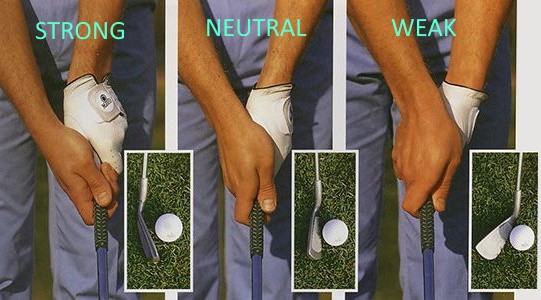How to Grip a Golf Club: 5 Simple Steps

Learning how to grip a golf club properly is crucial for control, accuracy, and power in your shots.
In this guide, we’ll take you through the step-by-step process of gripping a golf club, covering key techniques and considerations.
By mastering the art of the grip, you’ll lay a solid foundation for consistent and successful swings.
Get ready to elevate your golf game by perfecting your grip technique.
How to Grip a Golf Club: Beginners Guide

Step 1: Place Your Left Hand on the Grip
Now, let’s focus on the placement of your left hand.
Wrap your fingers around the grip, making sure to maintain a secure hold while keeping a relaxed grip pressure.
Your left thumb should be positioned on top of the grip, pointing slightly to the right of center.
This position helps with control and stability during your swing.
Step 2: Place Your Right Hand on the Grip
The right hand is responsible for providing balance and control as you swing the club.
To position your right hand correctly, start by placing it just below your left hand.
Your right pinky finger should overlap the gap between your left index and middle fingers.
Your right thumb should align with the left thumb, forming a “V” shape that points towards your right shoulder.
This grip will help you to swing the club with power and accuracy.
Step 3: Find the Proper Golf Grip
There are three main types of golf grips:
- Interlocking Grip
- Overlapping Grip
- Ten Finger Grip

Interlocking Grip
The interlocking grip is a golf grip where the little finger of the right hand is intertwined between the index and middle fingers of the left hand. This grip is often used by golfers with smaller hands, as it helps to keep the hands together and prevents them from rotating too far to the right or left.
To grip the club in an interlocking grip, follow these steps:
- Place your left hand on the grip with the heel pad of your palm on top of the grip and your fingers pointing down towards the ground.
- Place your right hand on the grip just below your left hand, with the little finger of your right hand interlaced between the index and middle fingers of your left hand.
- Wrap your remaining fingers around the grip, with your right thumb overlapping your left thumb.
- Apply pressure to the grip with both hands, making sure that your grip is firm but not too tight.
- Check your grip alignment by making sure that the V formed between your thumbs and forefingers points to your right shoulder.
The interlocking grip can be a good option for golfers who are looking for a comfortable and consistent grip. It can also help to prevent golfers from gripping the club too tightly, which can lead to tension and inconsistent swings.
Overlapping Grip
The overlapping grip is a golf grip where the little finger of the right hand rests on top of the gap between the index and middle fingers of the left hand. This grip is similar to the interlocking grip, but instead of wrapping the little finger around the index finger, you simply place it on top of it.
To grip the club in an overlapping grip, follow these steps:
- Place your left hand on the grip with the heel pad of your palm on top of the grip and your fingers pointing down towards the ground.
- Place your right hand on the grip just below your left hand, with the little finger of your right hand resting on top of the gap between the index and middle fingers of your left hand.
- Wrap your remaining fingers around the grip, with your right thumb overlapping your left thumb.
- Apply pressure to the grip with both hands, making sure that your grip is firm but not too tight.
- Check your grip alignment by making sure that the V formed between your thumbs and forefingers points to your right shoulder.
The overlapping grip can be a good option for golfers who are looking for a comfortable and consistent grip. It can also help to prevent golfers from gripping the club too tightly, which can lead to tension and inconsistent swings.
Ten Finger Grip
The ten finger grip is a golf grip where all ten fingers are wrapped around the grip without interlocking or overlapping them. This grip is often used by golfers with small hands or who have difficulty gripping the club with a more traditional grip.
To grip the club in a ten finger grip, follow these steps:
- Place your left hand on the grip with the heel pad of your palm on top of the grip and your fingers pointing down towards the ground.
- Place your right hand on the grip just below your left hand, with all ten fingers wrapped around the grip.
- Apply pressure to the grip with both hands, making sure that your grip is firm but not too tight.
- Check your grip alignment by making sure that the V formed between your thumbs and forefingers points to your right shoulder.
The ten finger grip can be a good option for golfers who are looking for a comfortable and consistent grip. It can also help to prevent golfers from gripping the club too tightly, which can lead to tension and inconsistent swings.
Step 4: Apply Pressure
The grip pressure you use when golfing can have a big impact on your swing. A too-tight grip can lead to tension and inconsistency, while a too-loose grip can make it difficult to control the clubface. The best way to find the right grip pressure for you is to experiment and see what feels most comfortable.
A good rule of thumb is to grip the club with a firm but relaxed grip. You should be able to wiggle your fingers slightly without the club slipping out of your hands. If you find that your hands are getting tense, try loosening your grip slightly. And if you find that the club is slipping out of your hands, try gripping it more tightly.
You can also try the “1-2-3” grip pressure method. To do this, start by gripping the club with a firm grip. Then, count to 1 and relax your grip slightly. Count to 2 and relax your grip even more. And count to 3 and relax your grip until it feels just right.
The right grip pressure will vary from person to person, so it’s important to experiment and find what works best for you. But once you find the right grip pressure, you’ll be well on your way to hitting more consistent shots.
Step 5: Understanding Golf Grip Strength
In addition to the grip styles above, there are also three types of grips based on hand position: weak, neutral, and strong. These grips are not about how tightly you grip the club, but rather the rotational position of your hands on the shaft.
Weak, neutral, and strong grips are typically associated with fade, straight, and draw ball flights, respectively. Swing problems such as slicing or hooking the ball are often caused by grips that are too weak or too strong.
Most golfers start out with a neutral grip, which can be adjusted to a weak or strong grip as needed. It is possible to be a successful golfer with a neutral grip only, but if you want to try something different, you can achieve a weak or strong grip by rotating your hands left or right from a neutral grip position.

Weak Grip
A weak grip in golf is a grip where the hands are rotated more to the left on the grip. This causes the clubface to be more open at address, which can promote a fade or slice ball flight.
Here are some of the characteristics of a weak grip:
- The V formed by the index finger and thumb of the left hand (for right-handed golfers) points to the left shoulder.
- The left hand is more under the grip than over the top.
- The right hand is more on top of the grip than under the grip.
A weak grip can be a good option for golfers who:
- Tend to slice the ball.
- Have slower swing speeds.
- Want to hit a fade shot.
However, a weak grip can also make it difficult to hit a draw shot. If you are struggling with a slice, a weak grip can be a good way to start correcting the problem. However, if you are a draw player, you may want to consider using a stronger grip.
Neutral Grip
A neutral grip in golf is a grip where the hands are in a natural position on the grip, with the V formed by the index finger and thumb of the left hand (for right-handed golfers) pointing to the right shoulder. This is the most common type of grip used by golfers, and it is a good option for golfers who want to hit a straight ball flight.
Here are some of the characteristics of a neutral grip:
- The hands are in a relaxed position on the grip.
- The V formed by the index finger and thumb of the left hand points to the right shoulder.
- The left hand is slightly under the grip, and the right hand is slightly on top of the grip.
A neutral grip can be a good option for golfers who:
- Want to hit a straight ball flight.
- Have a moderate swing speed.
- Are comfortable with a traditional grip.
However, a neutral grip may not be the best option for golfers who:
- Struggle with a slice.
- Have a slow swing speed.
- Want to hit a draw shot.
If you are struggling with a slice, you may want to try a stronger grip. And if you want to hit a draw shot, you may want to try a weaker grip.
Strong Grip
A strong grip in golf is a grip where the hands are rotated more to the right on the grip. This causes the clubface to be more closed at address, which can promote a draw ball flight.
Here are some of the characteristics of a strong grip:
- The V formed by the index finger and thumb of the left hand (for right-handed golfers) points to the right side of the head.
- The left hand is more under the grip than over the top.
- The right hand is more on top of the grip than under the grip.
A strong grip can be a good option for golfers who:
- Want to hit a draw shot.
- Have a fast swing speed.
- Struggle with a slice.
However, a strong grip can also make it difficult to hit a fade shot. If you are struggling with a hook, a strong grip can be a good way to start correcting the problem. However, if you are a fade player, you may want to consider using a weaker grip.
FAQ:
How do you grip irons vs drivers?
The grip for irons and drivers is essentially the same, but there are a few subtle differences that can affect your ball flight.
- Grip pressure: Drivers are typically hit with a more powerful swing, so you may need to grip the club a little tighter with your driver than you do with your irons. However, don’t grip the club too tightly, or you’ll lose your feel for the club and your swing will become inconsistent.
- Grip rotation: Some golfers find that they need to rotate their grip slightly more to the right (for a right-handed golfer) when they’re hitting a driver. This helps to close the clubface at impact, which can help to prevent a slice. However, if you find that rotating your grip too much causes you to hook the ball, then you’ll need to adjust it back to a more neutral position.
- Grip style: There are three main grip styles: interlocking, overlapping, and ten-finger. The interlocking grip is the most popular, but the overlapping grip and ten-finger grip can also be effective. Experiment with different grip styles to see which one feels most comfortable to you.
Ultimately, the best way to find the right grip for your irons and drivers is to experiment and see what works best for you. There is no one-size-fits-all answer, as the ideal grip will vary depending on your individual swing and preferences.
Executive Summary.
A proper golf club grip is vital for control and accuracy in your game. By following the steps outlined in this guide and practicing regularly, you can perfect your grip technique. Embrace the art of the grip, and experience improved performance on the course. Elevate your game by mastering your golf club grip and enjoy the results in every swing.